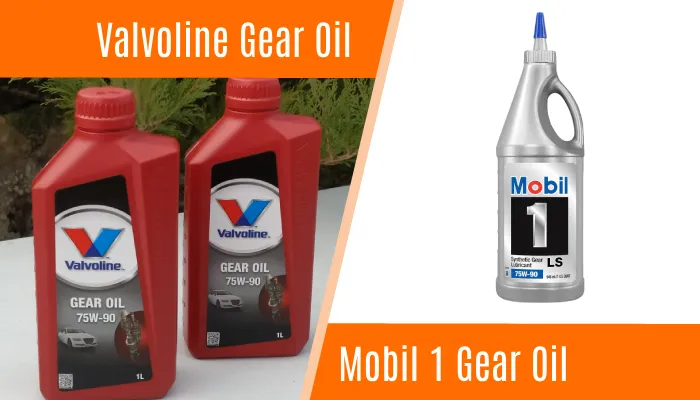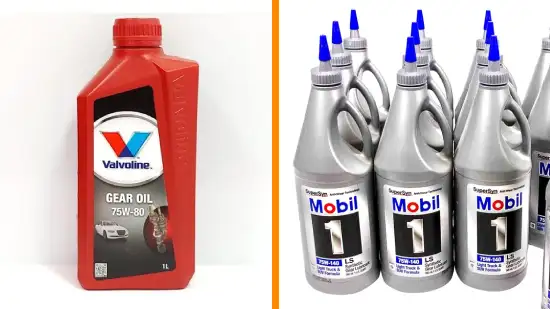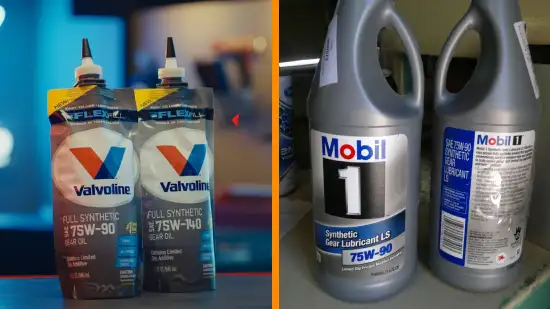Physical Address
304 North Cardinal St.
Dorchester Center, MA 02124
Physical Address
304 North Cardinal St.
Dorchester Center, MA 02124

Valvoline and Mobil 1 gear oil are two leading synthetic lubricants used in automotive applications. Both companies are known for their high-quality products that optimize the performance and durability of differentials.
While they share common characteristics, it’s the subtle differences that set them apart and cater to varying automotive needs.
Valvoline and Mobil 1 gear oils differ significantly in terms of their fluidity and temperature range. Mobil 1’s gear oil is engineered to excel even in arctic conditions, maintaining outstanding low-temperature fluidity for optimal performance.
On the other hand, Valvoline’s gear oil is celebrated for its versatility, effectively functioning across a broad spectrum of temperature extremes, making it a reliable choice for various car applications.
We will explore all the distinctions between Valvoline and Mobil 1 gear oil to help you decide which oil to choose for your vehicle.

Below are the key differences that set Valvoline and Mobil 1 gear oils apart, each catering to distinct preferences and requirements in automotive lubricants.
Now, take a closer look at five key attributes that set Valvoline and Mobil 1 gear oils apart, helping you make the right decision for your automotive needs.
To understand the distinctions between Valvoline and Mobil 1 gear oil, you need to consider their fluidity and temperature range capabilities.
Mobil 1’s Syn Gear Lube LS 75W-90 is specifically formulated to maintain excellent low-temperature fluidity, even in extreme cold conditions. This means that it can provide optimal performance in arctic climates, where other gear oils may struggle to flow smoothly.
Conversely, Valvoline’s SynPower Gear Oil is known for its versatility in both high and low-temperature extremes. This makes it suitable for a wide range of car applications, whether you’re driving in scorching hot summers or freezing cold winters.
Valvoline gear oil is fortified with special additives designed to protect gear teeth from rust and corrosion. This helps to reduce chattering in limited-slip differentials, ensuring smooth and efficient operation.
Conversely, Mobil 1 gear oil utilizes proprietary formulations specifically engineered to resist thermal and oxidative degradation, wear, and corrosion. These additives enhance the overall lifespan of gears and bearings in car differentials, resulting in improved performance and durability.
Both Valvoline and Mobil, 1 gear oil, have carefully selected additive packages that cater to the unique needs of automotive gear systems, providing reliable protection and optimal performance.
Valvoline’s SAE 75W-90 Full Synthetic Gear Oil meets API GL-5 and GL-4 specifications, ensuring compatibility with a wide range of car differentials.
This means that Valvoline gear oil has been rigorously tested and approved by the American Petroleum Institute for use in differentials that require these specific performance levels.
On the other hand, Mobil 1’s Syn Gear Lube LS 75W-90 meets API GL-5 requirements, signifying its suitability for high-performance vehicles.
The API GL-5 certification indicates that Mobil 1 gear oil has passed tests for extreme pressure protection, anti-wear properties, and compatibility with different gear materials.
Both Valvoline and Mobil 1 gear oil meet industry standards, but their specific approvals and certifications may vary.
Density plays a crucial role in determining the behavior and performance of gear oil in automotive applications, particularly in car differentials.
Mobil 1 gear oil, with a density of 0.859 g/ml, exhibits a specific gravity that allows for efficient fluid flow and lubrication within the differential system.
Conversely, Valvoline gear oils generally have a density of approximately 0.850 to 0.875 g/ml. This density range ensures that Valvoline gear oils possess the ideal viscosity and lubricity to withstand the demanding conditions of car differentials. Consequently, the gears are well protected, and wear and tear are reduced.
The slight variation in density allows Valvoline gear oils to adapt to different environments and applications, ensuring optimal performance and longevity in car differentials.
Pricing and affordability are important factors when comparing Valvoline and Mobil 1 gear oil. Valvoline’s SAE 75W-90 Full Synthetic Gear Oil is competitively priced, although it’s typically available at a slightly higher price point compared to Mobil 1.
In contrast, Mobil 1 often offers affordability and cost savings, making it an attractive option for car owners. While Valvoline may be priced slightly higher, it’s important to consider each brand’s overall value and performance.
| Aspect | Valvoline Gear Oil | Mobil 1 Gear Oil |
| Fluidity and Temperature Range | Effective in high and low-temperature extremes, versatile for a range of car applications | Maintains excellent low-temperature fluidity even in extreme cold, ideal for arctic conditions |
| Additive Packages | Incorporates additives for gear protection, reducing rust, corrosion, and chattering in limited-slip differentials | Improves gear and bearing life by resisting thermal and oxidative degradation, wear, and corrosion |
| Approvals and Certifications | Meets API GL-5 and GL-4 specifications, compatible with a wide range of car differentials | Meets API GL-5 requirements, suitable for high-performance vehicles |
| Density | Varies based on specific products, generally between about 0.850 to 0.875 g/ml | Density of 0.859 g/ml, impacting fluid flow and performance in car differentials |
| Pricing and Affordability | Competitively priced but often slightly higher compared to Mobil 1 | Affordable and cost-saving, making it an attractive option |
Follow these instructions to change the gear oil in your vehicle:
Before starting, make sure you have all the necessary tools and materials ready to change the gear oil of your vehicle. An efficient and smooth process depends on these items.
First, you’ll need a socket and ratchet set to remove the drain plug. This will allow the old gear oil to be drained into a drain pan, so be sure to have one on hand. Additionally, a wrench may be necessary to loosen any stubborn plugs or bolts.
To add the new gear oil, a funnel will help prevent spillage and ensure precise pouring. It’s important to use the appropriate gear oil for your specific vehicle, so make sure you have the correct type and quantity.
Also, don’t forget to wear safety gear such as gloves and safety glasses to protect yourself during the process.
Once you have gathered your tools and materials, it’s important to locate the drain and fill plugs on your vehicle’s transmission or gearbox. These plugs are essential for changing the gear oil.
To find them, you’ll need to inspect the bottom and side of the gearbox. The drain plug is typically located at the lowest point of the transmission or gearbox, often at the bottom of a pan. It’s used to remove the old gear oil.
The fill plug, on the other hand, is usually positioned higher up and is used to add the new gear oil. Look for plugs that are hexagonal or square-shaped, as these are commonly used for drain and fill purposes.
Once you have identified the drain and fill plugs, you’re ready to proceed with changing the gear oil.
Now, position the drain pan directly beneath the gearbox to ensure that it collects the old oil when you remove the drain plug. This step is crucial to prevent any oil spillage and minimize the mess.
Take your time to align the drain pan accurately, making sure it’s directly under the drain plug. You may need to maneuver the pan slightly to get the perfect positioning.
The drain pan should have a capacity that can accommodate the entire volume of the gear oil. It should also be able to handle the weight of the oil without any risk of overflowing.
Placing the drain pan securely beneath the gearbox will allow for a clean and efficient oil change process.
To begin changing the gear oil of your vehicle, start by using a socket or wrench to carefully remove the drain plug. This plug is usually located at the bottom of the gearbox. Before you begin, make sure you have a drain pan positioned underneath to catch the old oil.
As you loosen the drain plug, be prepared for the oil to flow out of the gearbox and into the pan. The oil may appear dirty and discolored, which is a clear indication that it needs to be changed.
Take caution when removing the plug to ensure that you don’t drop it into the drain pan or onto the ground. Once the plug is completely removed, set it aside in a safe place for reinstallation later.
To remove the fill plug and continue changing the gear oil of your vehicle, carefully use a socket or wrench to loosen the plug.
The fill plug is an essential component in the process of changing the gear oil. It allows for proper drainage and prevents the formation of a vacuum that can hinder the process.
By removing the fill plug, you create a pathway for the old oil to drain out completely, ensuring a thorough oil change. It’s important to be cautious when loosening the plug to avoid damaging it or the surrounding components.
Once the old oil has drained, the fill plug can be securely reinstalled before pouring the new oil into the gearbox. This step ensures that the new oil remains inside the gearbox, promoting optimal performance.
You should use a funnel to fill your gearbox with the correct type and quantity of new gear oil as specified in your vehicle’s manual. Before starting, make sure you have the recommended gear oil on hand and that it meets the manufacturer’s specifications.
Locate the fill plug on the gearbox, which is usually located on the side or top of the transmission case. Remove the plug and place the funnel securely in the opening.
Slowly pour the new gear oil into the funnel, being careful not to overfill. Refer to your vehicle’s manual for the specific quantity of gear oil required.
Once you have filled the gearbox to the correct level, replace the fill plug and tighten it securely.
Continuing from the previous step, now inspect the area around the drain and fill plugs for any signs of leaks.
It’s crucial to perform this inspection to ensure there are no leaks that could compromise the effectiveness of the gear oil.
Leaks can occur due to worn seals or damaged threads on the plugs. Carefully examine the surrounding area for any wetness, drips, or stains, which may indicate a leak.
Pay close attention to the drain plug, fill plug, and the surrounding surfaces. If you notice any leaks, it’s important to promptly address them before proceeding further.
Failure to address leaks can lead to gear oil loss, resulting in inadequate lubrication and potential damage to the transmission or differential.
After checking for leaks, proceed to dispose of the old gear oil in an environmentally responsible manner. It’s crucial to handle the disposal of used oil properly to protect the environment.
Many auto parts stores and recycling centers are equipped to accept used oil for proper disposal. Start by placing a drain pan under the vehicle to collect the old oil as it drains out.
Once all the oil has been drained, transfer it to a clean, sealed container. Make sure to label the container as used oil and keep it away from children and pets.
Don’t mix the used oil with any other substances, as this can contaminate the recycling process. Finally, take the container to a recycling center or an auto parts store that accepts used oil.

Valvoline and Mobil 1 gear oils demonstrate environmental friendliness in their formulations. Both companies prioritize minimizing their environmental impact, ensuring that their gear oils meet industry standards for eco-friendliness.
Using these gear oils in your vehicle can contribute to responsible automotive maintenance practices and reduce your carbon footprint.
Valvoline and Mobil 1 gear oils are designed to be environmentally safe when used and disposed of properly. It’s important to follow local regulations for the correct disposal of used gear oil to protect the environment further.
With Valvoline and Mobil 1, you can have confidence in their commitment to environmental responsibility and make a positive impact on our planet. Choose gear oils that prioritize the environment for a greener automotive maintenance solution.
The durability of Valvoline gear oil in your car’s differential can vary depending on driving conditions and maintenance practices.
Under regular use, Valvoline gear oil is designed to provide extended service intervals, typically lasting up to 50,000 miles before requiring a change. However, it’s important to consider the driving conditions you typically encounter.
If your driving involves severe conditions such as towing heavy loads or driving in extreme temperatures, changing the gear oil more frequently, usually every 15,000 to 20,000 miles is recommended. This ensures that your car’s differential receives optimal protection and performance, especially in demanding situations.
When comparing Valvoline and Mobil 1 gear oils, it’s clear that both brands offer high-quality options for car differentials. Their performance, certifications, and environmental friendliness make them excellent choices for automotive maintenance.
Whether you prioritize low-temperature fluidity or versatility in extreme conditions, Valvoline and Mobil 1 have you covered.
The life of Valvoline gear oil in your car’s differential depends on your driving habits, but generally, it provides extended service intervals.
So, the next time you decide on the right gear oil, consider your specific needs and rest assured that both Valvoline and Mobil 1 deliver reliable solutions for your vehicle’s well-being.
Last update on 2025-07-18 / Affiliate links / Images from Amazon Product Advertising API